Commercial Farming is the production of crops, raising of livestock, or both with the sole intent of making profits.
It is typically practiced at a large scale to leverage economies of scale and benefit from market efficiencies and the latest technologies to maximize profit.
The Commercial Farming industry has seen its fair share of changes over the past few decades where large farms, high-yield variety seeds, mechanization, automation and technological innovations have helped keep food costs low while allowing farmers to produce more in less time and less space.
At the same time, the growth of consumers wanting alternate choices like vegan or organic or sustainable or “locally produced” has forced Commercial Farmers to change the way they do business and cater to these new and growing market segments.
Commercial Farming is a complex business that requires an understanding of the land, the people who work it, the produce that is grown or raised, the technologies that maximize efficiencies and the dynamics of the market where profits are made.
Many factors impact the ability to succeed in this competitive industry, so it’s important to be prepared. And this comprehensive guide on Commercial Farming is a great place to start!

Topics
Here’s what we’ll cover in this article.
- What is Commercial Farming?
- Characteristics of Commercial Farming
- The Importance of Commercial Farming
- Different Types of Commercial Farming
- Advantages and Disadvantages of Commercial Farming
- Commercial Farming Vs Subsistence Farming
- Commercial Farming Vs Intensive Farming
- Commercial Farming Vs Organic Farming
- Examples of Commercial Farming
- Commercial Worm Farming
- Commercial Bamboo Farming
- Commercial Grain Farming
- Commercial Fish Farming
- Commercial Cricket Farming
- Key Takeaways
- Frequently Asked Questions
What is Commercial Farming?
Commercial farming is the business of raising, growing and selling crops or animals as food or raw materials with the objective of making a profit.
Based on this definition, commercial farms do not have to be large. They just need to have profit as an intent.
But usually, Commercial Farming refers to farming at a large scale, with significant capital investments in land, raw materials, infrastructure and technology to achieve profit levels that can only result from economies of scale.
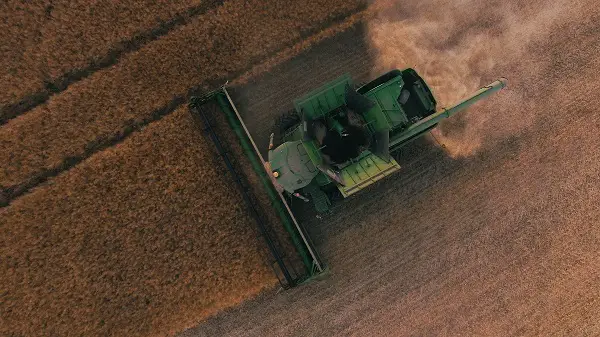
Commercial Farming has been on the rise, especially due to a large demand for food around the world with a population that has been growing at an exponential rate.
In this paper titled “Global agriculture towards 2050”, The Food and Agriculture Organization (FAO) of the United Nations has predicted that the world population will grow by a third or 2.3 billion people between 2009 and 2050. This means there will be 9.1 billion living on our planet.
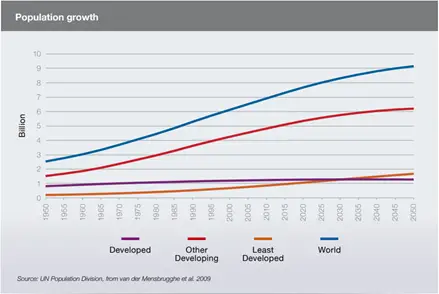
In the same paper, the FAO also predicted that “feeding a world population of 9.1 billion people in 2050 would require raising overall food production by some 70 percent between 2005/07 and 2050”
What’s clear is that there is no way that we can find 70% more arable land to grow and cultivate the crop needed to feed 9.1 billion people.
This means we need to find ways to produce more from the same arable land that we currently have and, that too, at a lower cost.
This is where Commercial Farming comes in with its business model of high volume and low unit cost of production.
However, the potential environmental impact of large-scale commercial farming is one we cannot ignore. The destruction of habitats from the conversion of wild land into agricultural land and the damage to the environment from the use of pesticides and fertilizers as well as from pollution is a cost that cannot be ignored.
So, the big question of our times is this: Can Commercial Farming help feed the world while doing so sustainably and without harming the environment?
Characteristics of Commercial Farming

Commercial Farming can be characterized by these 5 features:
1. Large-scale
2. Capital Intensive
3. High tech
4. Maximization of Crop Yields
5. All Farm produce is for sale
Large-scale
According to AgronoMag, the 10 largest farms in the world are found in China and Australia with the largest being a dairy farm in China with an area of 22 million acres and 100,000 head of cattle.
Farming at a large scale is essential if the objective is to maximize profits. Large farms are able to enjoy economies of scale that reduce the unit cost of production by spreading fixed costs like environment monitoring and marketing across a large production volume.
For instance, a cattle farm may need to monitor water and air pollution caused by the livestock. The cost of installing such equipment is mostly a fixed cost and can work out cheaper per pound of meat or a gallon of milk sold, when there is more head of cattle.
Large farms are also able to purchase in large volumes giving them greater negotiating power over their suppliers. This can reduce the unit cost of items like seeds, feed, fertilizers, pesticides and even technological equipment.
Capital Intensive
Their sheer size makes Commercial Farms a very capital-intensive business. Large investments are needed in land, equipment, machinery, vehicles, livestock and buildings.
Commercial farming is highly mechanized and requires a lot of equipment, from tractors, combines and harvesters to balers, cultivators and irrigation systems. Commercial farmers also need large trucks for transportation.
They need buildings where they can process or package produce that is harvested from the fields or raised on the farm. These can include barns, farmhouses, enclosures for livestock, coops for chickens, silos for grain and cold storage.
Large farms also need considerable Operating Capital. Running costs include payroll, supplies, fertilizers, feed, seed, water for irrigation, fuel, rent, taxes, interest on loans, maintenance costs, insurance, and more.
High tech
Commercial Farms are on the vanguard in the use of Agricultural Technology to maximize yields, minimize costs and maximize profits.
According to this article in Forbes, labor costs can range from 25% to 75% of a crop’s value. In the drive towards maximizing profits, commercial farms are automating everything including tractors which increasingly are autonomous and so do not require drivers. In fact, the same article states that by using autonomous tractors some farms have been able to save up to 80% of the labor costs in specific uses.
While this is not good news for farm labor, automation and the use of technology it is a characteristic of Commercial Farming.
According to AgFunder News, AgTech companies raised $24 billion in the first half of 2021 with investments ranging across the food value chain from online grocery stores to biotechnology.
Commercial Farmers will always remain early adopters of Agricultural Technological innovations as these usually help drive down costs and help grow profits.
Maximization of Crop Yields
Commercial Farming usually deploys all techniques possible to maximize crop yields.
This includes benign solutions like soil preparation, crop rotation, stress management, proper watering and irrigation, and the use of appropriate agricultural technology.
But it could also include harmful solutions like the use of high yield seeds, excessive chemicals, fertilizers, pesticides, etc. which could have a detrimental impact on the crop or livestock as well as on the environment.
All Farm produce is for sale
Throughout history, farming was practiced first and foremost to sustain the farmer’s family and only the excess was sold to society. Farming was always and only a family business.
Commercial Farming on the other hand is practiced solely with the intent of selling the entire produce on the market. Commercial Farms are profit-driven commercial enterprises that are now often owned by investors and shareholders. This makes them pure businesses like any other and not the “family farm” of previous centuries.
Different Types of Commercial Farming
Commercial Farming can be broadly classified based on various characteristics.
Commercial Farms classified based on the type of produce include:
- Dairy Farm
- Crop Farm
- Fruit Farm
- Livestock Farm
- Mixed Crop and Livestock Farm
- Aquaculture Farm / Fishery
Commercial Farms classified based on the style of production include:
- Intensive Farming
- Extensive Farming
- Organic Farming
Advantages and Disadvantages of Commercial Farming
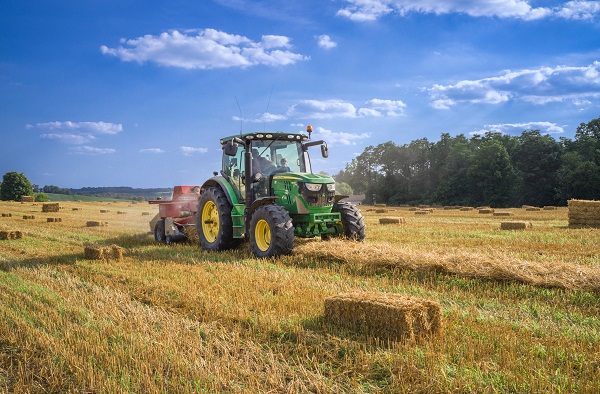
Advantages
1. Production on a massive scale increases food security
Production on a massive scale comes with the advantage that more types of food are available to more people than ever before.
For example, until the start of the 20th century, fish was usually only available to coastal communities because fish farming was virtually not practiced and the quantity in which fish was caught or grown wasn’t enough to ensure that everyone who wanted to eat fish could get it.
Today, many kinds of fish are available away from the coast and can be grown on fish farms inland.
The same was true for different kinds of fruit and vegetables. With the large-scale production of Commercial Farming, more food is produced and so more can be made available to everyone.
Production at scale also helps reduce food scarcity. Governments can purchase in larger qualities and store food to make it available to the public over time.
So large-scale production, improvements in transportation and storage can help improve food security.
2. Generates greater throughput per acre of land
As we’ve seen earlier in this article, Commercial Farming drives efficiencies to generate more yield per acre of land. If overall food production needs to grow by 70% to feed the world’s population in 2050 the only way is to extract more from the same land that we have.
The practices that Commercial Farming follows including the large scale at which it operates, its use of the latest technology, etc. are essential to generate greater throughputs with minimal increase in the use of our natural resources.
3. Creates new kinds of jobs
While Commercial Farming does do away with traditional farm jobs by replacing people with machines, it still creates new kinds of jobs. These are jobs that are more intellectual, require high education, and are high paying.
Jobs at modern Commercial Farms can include Farm Managers, Water Treatment Specialists, Food Technologists, Ecologists, Environmental Engineers, Veterinarians, etc.
4. Lowers unit price of produce
Commercial Farming generates economies of scale which help bring down the unit price of food produced. The lower cost of food makes food more accessible to more people further helping improve food security.
But the drive to lower food prices can come at a cost to the environment. We will cover this point in the section on the disadvantages of commercial farming later in this article.
5. Becomes a prime mover for new technologies
One of the big benefits of Commercial Farming at a large scale is that such enterprises are early adopters of the latest Agricultural Technologies.
They have the capital to invest and experiment with new technologies and they have the need to improve operations, reduce cost, increase efficiencies which can sometimes only come from new technologies and innovations.
When Commercial Farms become early adopters of new technologies, they pave the way for these technologies to mature and become available to everyone else.
Disadvantages
1. Conversion of more wild land into farmland
Commercial Farming requires large tracts of arable land which sometimes can only be obtained by eating into wild land.
As Commercial Farming grows, the risk of losing more wild land to farmland increases. According to Greenpeace, 80% of global deforestation is a result of agricultural production.
Deforestation not only denies safe habitats to wild animals and birds who form a crucial link in our ecosystem, its negative side effects also include soil erosion, increased greenhouse gases, increase in global warming, flooding in some parts of the world, and droughts in other parts.
If you’re interested in reading more about the effects of deforestation here are two great reads. The first is from the World Wildlife Fund and the other from National Geographic.
Both organizations have excellent films on this topic.
The National Geographic on Deforestation:
The WWF on food as the primary cause of Deforestation:
2. Loss of traditional farm jobs
Commercial Farming mechanizes and automates many traditional jobs. With the growth of commercial farming, these jobs could disappear in the future.
This could cause large displacements of people from farms towards cities. Unfortunately, such people do not have the skills or education needed for “city jobs” and so risk entering poverty and homelessness. This is especially true in developing countries where large portions of the population work on traditional farms.
3. Damage to the environment
Commercial Farming requires treatment and disposal of large quantities of waste, chemicals, drugs (eg. antibiotics) and hormones. If these get inappropriately released into the environment, they can contaminate water sources and eventually affect humans.
Techniques used in Commercial Agriculture including excessive use of pesticides and fertilizers can hurt the health of the soil. If you’d like to learn how Industrial Agriculture can adversely affect soil, here’s an good article from foodprint.org.
4. Health Risks
Potential Health Risks from Commercial Farming are of two types: Risk to workers and risk to consumers.
The risks to farmers and workers can stem from over-exposure to chemicals, fertilizers, pesticides and manure. Health risks for farmers include respiratory illnesses, skin problems, cancer and cardiovascular problems.
The risk to consumers stems from the excessive use of pesticides and fertilizers which can seep into the farm produce and eventually onto our plates. Other reasons for the contamination of farm products include inadequate on-farm food safety practices, improper worker health, hygiene and safety, poor post-harvest sanitation and insufficient traceability.
Commercial Farming Vs Subsistence Farming
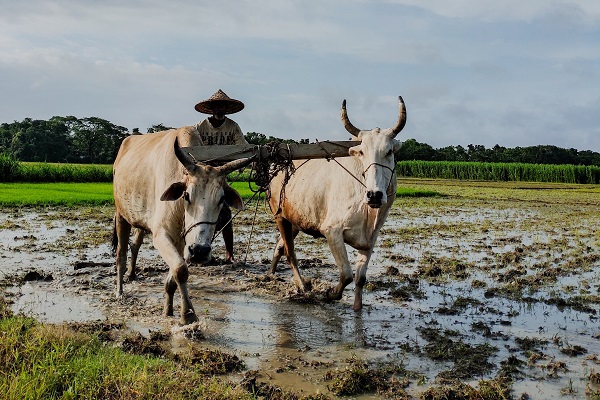
As we’ve seen throughout this article, Commercial farming is a type of agriculture that focuses on the production of crops or livestock for sale in order to generate a profit.
In contrast, Subsistence Farming is the practice of producing enough food to meet the needs of the farmer’s family. So, Subsistence farmers are concerned with providing for their families and the selling of a portion of their produce to others is a secondary thought.
Unlike Commercial Farming, Subsistence Farming often relies on traditional methods and organic farming practices.
Commercial farmers also tend to use monoculture production methods to maximize yield and profits, while Subsistence Farmers often diversify their crops to improve soil health and protect against pests and disease.
Commercial Farming Vs Intensive Farming
Intensive Farming is a type of Commercial Farming characterized by high inputs of labor, capital, and management in order to produce high yields.
Intensive farming is used in many developed countries as a way of increasing food production from a given amount of land.
The main drawback to intensive farming is that it is often expensive, and the high yields come at the expense of quality.
Commercial Farming Vs Organic Farming
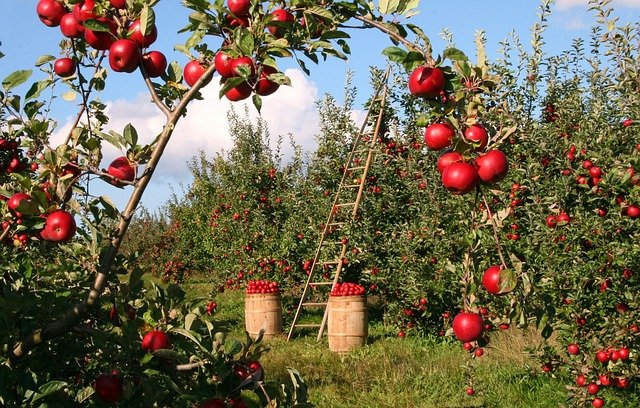
Organic Farming is the type of farming in which crops and livestock are grown or raised without using commercial fertilizers, pesticides, chemical enhancements or genetically modified organisms.
Organic Farming not just involves using organic raw materials but rather is a holistic approach to farming that is done sustainability and in harmony with the environment.
As you can imagine, Organic Farming is more expensive to practice than Commercial Farming which has profit-maximization as an objective.
This logic might make us consider Organic Farming as the antithesis of Commercial Farming. But that’s not always the case, as Organic Farming can also be practiced for commercial reasons though this is usually done at a relatively smaller scale.
Efforts are being made to practice organic farming at a large scale so that in the future commercial farming can also be done organically.
If you have more questions about organic farming, we’d like to refer you to an excellent FAQ section on The Organic Farming Research Foundation’s website.
Examples of Commercial Farming
In this article, we’ll look at the following examples of Commercial Farming:
- Worm Farming
- Bamboo Farming
- Grain Farming
- Fish Farming
- Cricket Farming
Commercial Worm Farming
Worm Farming, also called Vermiculture, is the artificial cultivation of worms generally for the purposes of Vermicomposting.
Vermicomposting is the process of using worms to convert organic waste into a rich hummus-like fertilizer called the Vermicast.
Vermicast is an organic fertilizer used in organic farming.
Worm Farming can be a very lucrative business as this video shows:
Commercial Bamboo Farming

Bamboo is a tough, robust and resilient plant that has been used for centuries as an alternative to hardwoods.
Commercial farming of Bamboo began in the United States during the early 20th century and is now widespread, with around 95% of all commercially available bamboo planted on plantations rather than grown naturally.
Bamboo is a versatile plant with many uses in construction, furniture, ornamental gardening, medicines, fuel, food and even in the building of roads.
Flooring: One popular use of bamboo is flooring, as bamboo is typically cheaper than hardwood. Commercial growers usually harvest the shoots of the plant and peel away their outer sheaths to expose the inner woody core which can then be dried and used for manufacturing flooring material. Another popular use of Bamboo is in construction materials such as scaffolding and, in China, even entire houses.
Furniture: Bamboo is also popularly used for making furniture, especially in Asian countries where bamboo grows plentifully. Pieces made of bamboo are often light and delicate, but also sturdy.
Food: A less common use of bamboo is as a food crop. The shoots of the bamboo plant can be harvested and eaten either raw or cooked. They have a crunchy texture and a slightly sweet taste that makes them a popular vegetable in several Asian countries.
Firewood: Commercial growers often use Bamboo as a source of firewood, especially in areas where it is not the primary crop. The dense wood of the bamboo plant burns slowly and with a hot flame, making it an ideal fuel for fires.
Paper: Bamboo is also used to make paper, as the plant is fast-growing and can be harvested repeatedly. Long bamboo fibers make excellent quality paper, which is often used for printing and writing.
Crafts: Bamboo is also popularly used for making crafts, such as baskets, wind chimes, and other decorative items. The soft wood of the bamboo plant can be easily carved and shaped, making it a favorite material for crafting enthusiasts.
Commercial Grain Farming
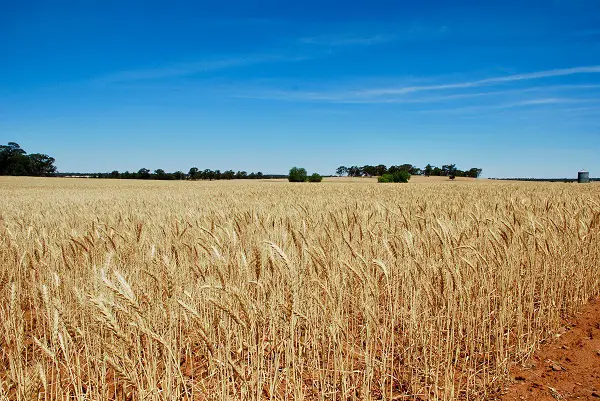
In Commercial Grain Farming grains such as wheat, corn, rice, quinoa, millet, rye, barley and oats are grown.
Grain farmers face challenges of insufficient land area for agriculture, soil erosion, loss of soil fertility, climate change and reducing prices.
Grain farming is highly mechanized and so requires large investments in equipment like planters, harvesters, combines, tractors and trucks. Investment is also needed in grain storage structures like silos.
Grain farmers need to know how to prepare fields and understand the varieties of grain that they can grow. They need to learn how to control pests, insects, weeds and treat plants for disease. Grain farming also comes with a lot of uncertainty as costs are large but predictable while market prices are fluctuating and unpredictable.
Commercial Fish Farming
Commercial Fish Farming is the artificial breeding of fish in enclosures like tanks or artificial ponds.
Commonly grown fish include salmon, cod, tuna, trout catfish and tilapia.
Fish are high in protein and many people looking for a non-animal meat protein option turn to fish as a healthy alternative. This is increasing the global demand for fish making Commercial Fish Farming a lucrative business.
One problem with commercial fish farming is that most farms are located close to the coast. While this makes them easy to access and maintain, they tend to have a negative impact on the environment.
This problem is giving rise to deep water fish farms which are located several miles from the coast.
If you’re interested in the topic of deep water fish farms, here’s a short but interesting video from the World Economic Forum:
Commercial Cricket Farming
Crickets are already considered a delicacy in many parts of Asia and interest in them, as a source of protein, is growing in the rest of the world.
If you compare the amount of protein in crickets with that in beef, the same quantity of crickets contains twice as much protein as does beef. And so many look at crickets as a source of sustainable protein.
So, it’s little wonder that crickets are now found in products like Cricket Protein Powders, Cricket Protein chips, Cricket Protein bars, Cricket Protein chocolate powder, Cricket Protein butter and Cricket flour.
If you’d like to learn more about this growing industry here’s a video from Business Insider:
And if you’re interested in setting up a sustainable cricket farm, here’s a guide from the UN’s Food and Agriculture Organization – the FAO – to help you get started.
Key Takeaways
- Commercial Farming is a business. A business in which crops and/or livestock are grown and sold with the intent of making a profit.
- Commercial Farming is typically practiced at very large scales to leverage economies of scale, maximize efficiencies, minimize costs and maximize profits.
- According to the FAO, there will be 9.1 billion people living on our planet by 2050 and food production would need to increase by 70% to feed everyone. This means Commercial Farming with its efficiencies, high volume and lower unit cost will play a significant role in feeding the masses.
- Commercial Farming is usually an early adopter of new agricultural technologies paving the way for these technologies to be widely used later on.
- Commercial Farming is usually characterized by excessive use of fertilizers, pesticides and other chemicals. This can be bad for the environment as well as for human health.
- Commercial Farming is farming for pure profit. In this sense, it is distinct from Subsistence Farming which is practiced with the goal of feeding a family or a small community.
- Commercial Farming is usually also Intensive Farming where large amounts of inputs are used to extract large amounts of outputs from the land.
- Organic Farming can also be commercial in nature, in the sense that all the organically grown produce is destined to be sold for a profit.
- Common Examples of Commercial Farming include:
The Farming of Crops: Wheat, Rice, Corn, Tea, Coffee, Sugarcane, Cotton, Bananas, other types of Fruit and many more.
The Farming of Livestock: Cows, Sheep, Goats, Worms, Fish, Snails, Chickens, Fish, Crickets. - Commercial Farming has an important role to play in feeding the world in the decades to come. The question is – Can this be done sustainably and without harming the environment?
Frequently Asked Questions
1. Where is Commercial Farming Practiced?
Commercial Farming is practiced in all parts of the world, though the largest commercial farms are found in China, Australia, Brazil and the United States.
Here are some lists of the largest commercial farms around the world:
- AgronoMag – Top 10 Biggest Farms in the World
- Successful Farming – Top 5 Farms with the largest acreage in the U.S.
- Farm Progress – Largest farms in Brazil
- LaScalA – Australia’s largest cattle farms
2. What is the difference between Commercial Farming and Subsistence Farming?
Commercial farming is the business of producing crops or animals with the objective of selling them for a profit.
Subsistence Farming is not a business. Rather, it is the practice of growing food to feed a single family (the farmer’s) or a small community.
Commercial Farming is usually practiced at a large scale with the intent of leveraging economies of scale to maximize profit.
Subsistence Farming, on the other hand, is almost always practiced on a small scale with all members of a family working in the fields to put food on the table. Subsistence Farming is also generally characterized by poverty and a hand-to-mouth existence.
3. Is Dairy Farming Commercial or Subsistence?
Dairy Farming is a form of Commercial Farming though it need not be large-scale farming as is characteristic of most Commercial Farming.
In many parts of the world, dairy farms are small and family-owned. But the milk produced is, for the most part, destined to be sold on the market. This is what makes Dairy Farming a commercial enterprise.
Dairy Farming can also be practiced on a large scale. In fact, the largest dairy farm in the world can be found in China. The Mudanjiang City Mega Farm is spread over 22,500,000 acres and has around 100,000 cows.
4. Why is Commercial Farming an expensive method of farming?
The objective of Commercial Farming is to maximize profits.
The maximizing of profits requires large investments in land, technology, infrastructure and raw materials.
Investments include tractors, combines, harvesters, irrigation systems, farm buildings, silos, enclosures for livestock, tanks for fish, cold storage, etc.
Commercial Farms also have high operating costs including payroll, purchasing of seed, feed, water, fuel as well as taxes and interest on loans. Also, the more equipment and technology used, the more it costs in maintenance, operation and insurance.
And so yes, Commercial Farming is an expensive (but lucrative) method of farming.
5. Why is Subsistence Farming less efficient than Commercial Farming?
Subsistence Farming is less efficient than Commercial Farming because of the following reasons.
1. Traditional Vs Modern Methods
Subsistence Farming uses traditional methods of farming which are manual and less efficient. Commercial Farming uses modern methods and is highly mechanized making it more efficient.
2. Polyculture Vs Monoculture
Subsistence Farmers typically practice Polyculture. Polyculture refers to rotating crops throughout the year so as to grow the right crop in the right season. While Polyculture is an ecologically-sound practice it is also less efficient than Monoculture where you grow a single type of crop.
Commercial Farming leans towards using monoculture production as this is the best way to maximize efficiency, yield and profits even though it can come at a cost to the environment.
3. Use of Fertilizers/Pesticides
Both Subsistence Farming and Commercial Farming use fertilizers and pesticides.
However, Commercial Farming tends to use these chemical enhancements at a scale much larger than that of Subsistence Farming.
Since the objective is to maximize profits, Commercial Farming avoids losing any crop to pests or diseases even if that means excessive use of pesticides.
Similarly, excessive use of fertilizer can give a larger crop yield.
Therefore, the irony is that excessive use of Fertilisers and Pesticides in Commercial Farming makes it more efficient (but less sustainable) than Subsistence Farming where the farmer has to produce just enough to feed his family.
Sources & Further Reading
- The FAO – Global agriculture towards 2050
- Millman National Land Services – Types of Structures on Agricultural Land
- Hobby Farms – Names of Farm Equipment
- Statistics Canada – Operating Expenses on a Farm
- Forbes – New AgTech for Increasing Profitability
- UN Environment Programme –The downside of Industrial Farming
- Greenpeace – Agribusiness & Deforestation
- FoodPrint.org – How Industrial Agriculture Affects Our Soil
- The FAO – Guidance on sustainable cricket farming
